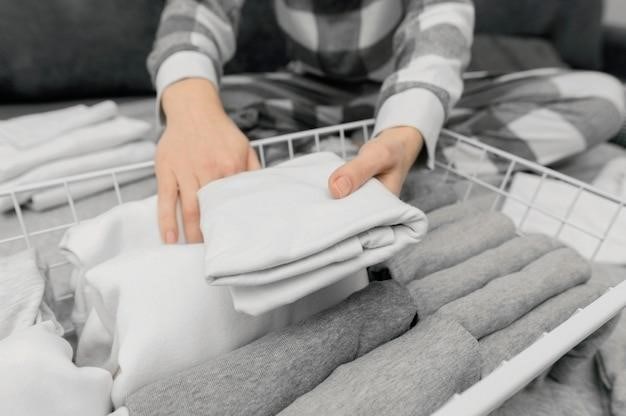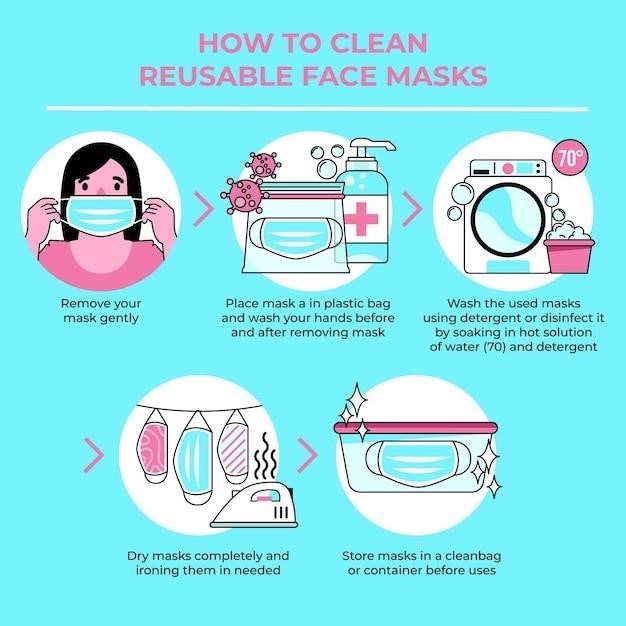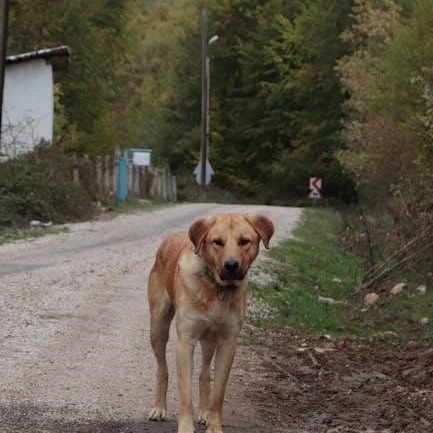Quilts are a cherished part of many households‚ providing warmth‚ comfort‚ and often sentimental value. To ensure your quilt remains in top condition for years to come‚ it’s crucial to follow proper washing instructions. This guide will cover everything you need to know‚ from machine washing to hand washing‚ drying‚ and special considerations for different types of quilts.
Introduction
Quilts are more than just bedding; they’re often treasured heirlooms‚ handmade gifts‚ or expressions of personal style. Washing a quilt can seem daunting‚ especially for those with delicate or vintage pieces. However‚ with the right approach and a few simple steps‚ you can keep your quilt looking its best and enjoying it for years to come. The key is to understand the materials and construction of your quilt and choose washing methods that are gentle enough to preserve its beauty and integrity.
This guide will provide a comprehensive overview of washing quilts‚ covering everything from machine washing and hand washing to drying techniques and special considerations for different quilt fillings. Whether you’re a seasoned quilter or a new owner of a cherished quilt‚ this information will help you make informed decisions about caring for your treasured textile.
Machine Washing
Machine washing can be a convenient option for many quilts‚ especially those made with modern fabrics. However‚ it’s essential to use the right settings and detergent to prevent damage. Always check the quilt’s care label for specific instructions‚ but here are some general guidelines⁚
- Choose the Gentle Cycle⁚ This setting provides a slower‚ more delicate wash that’s less likely to stress the seams and fabric of your quilt.
- Cold Water⁚ Washing in cold water helps preserve the colors and fibers of the quilt‚ minimizing shrinkage and fading.
- Mild Detergent⁚ Use a low-sudsing‚ fragrance-free detergent designed for delicate fabrics. Avoid using harsh chemicals or bleach‚ as they can damage the quilt’s fibers.
- Front-Loading Washer⁚ If possible‚ use a front-loading washing machine‚ as they tend to be gentler on fabrics than top-loading machines.
- Smaller Loads⁚ If your quilt is large or bulky‚ it’s best to wash it alone or with a few other similar items to avoid overloading the machine and ensuring a thorough wash.
Remember‚ even with these precautions‚ machine washing can still pose some risks‚ such as color bleeding or fabric warping. If you’re unsure about machine washing your quilt‚ it’s always wise to consult a professional cleaner.
Hand Washing
Hand washing is often considered the gentlest method for cleaning quilts‚ especially those with delicate fabrics‚ intricate stitching‚ or vintage designs. While it requires more time and effort than machine washing‚ it can help minimize the risk of damage and preserve the quilt’s integrity.

- Prepare the Workspace⁚ Choose a large‚ clean bathtub or sink. Avoid using harsh chemicals or detergents in the tub beforehand‚ as they could potentially damage the quilt.
- Fill with Water⁚ Fill the tub or sink with cool water‚ ensuring it’s deep enough to completely submerge the quilt.
- Add Detergent⁚ Use a mild‚ low-sudsing detergent specifically designed for delicate fabrics. Avoid using harsh chemicals or bleach.
- Gently Soak⁚ Submerge the quilt in the water and allow it to soak for about 30 minutes. Gently agitate the quilt by squeezing it up and down‚ avoiding any harsh rubbing or twisting.
- Rinse Thoroughly⁚ Drain the soapy water and refill the tub or sink with fresh‚ cool water. Gently agitate the quilt again to rinse out all the detergent residue.
- Drain and Squeeze⁚ Drain the water and gently squeeze out as much excess water as possible. Avoid twisting or wringing the quilt‚ which could damage the fabric or seams.
Hand washing requires patience and care‚ but it can be the best way to ensure your treasured quilt remains in pristine condition for years to come.
Drying
Drying a quilt properly is just as important as washing it‚ and it plays a crucial role in preserving its shape‚ color‚ and overall condition. While air drying is generally the safest and most recommended method‚ there are situations where using a dryer might be necessary. Here’s a breakdown of the drying process⁚
- Air Drying⁚ This is the preferred method for most quilts. Find a well-ventilated‚ shaded area outdoors or indoors. Spread the quilt flat on a clean‚ dry surface like a clothesline‚ drying rack‚ or even a clean‚ dry sheet laid out on the floor. Gently smooth out any wrinkles or folds to promote even drying.
- Using a Dryer⁚ If air drying isn’t feasible‚ you can use a dryer on a low heat setting. However‚ it’s important to note that high heat can damage the quilt’s fabric and colors. Use a gentle cycle and remove the quilt from the dryer while it’s still slightly damp. If the quilt is still wet‚ hang it to air dry for a few hours.
- Avoid Direct Sunlight⁚ Prolonged exposure to direct sunlight can fade the quilt’s colors. If drying outdoors‚ choose a shaded area or cover the quilt with a light sheet.
- Regularly Flip and Rotate⁚ Flip the quilt periodically during drying to ensure even drying throughout. This helps prevent uneven moisture and potential mildew growth.
- Ironing⁚ If needed‚ you can iron the quilt on a low heat setting using a pressing cloth to prevent scorching. Focus on ironing any wrinkles or folds that remain after drying.
Patience is key when drying a quilt. Allow it ample time to dry thoroughly‚ and avoid rushing the process. Proper drying helps preserve the quilt’s beauty and longevity for years to come.
Frequency of Washing
Unlike bedding like sheets and comforters‚ quilts should not be washed frequently. Overwashing can lead to color fading‚ stress on seams‚ and damage to delicate hand-sewn designs. While a fresh quilt feels lovely‚ it’s essential to strike a balance between cleanliness and preserving its integrity.
The ideal frequency for washing a quilt is every two to four times a year. This allows for ample time to air out and freshen the quilt between washes. However‚ several factors can influence this frequency⁚
- Usage⁚ If the quilt is used frequently‚ especially by children or pets‚ it may need washing more often.
- Soiling⁚ Visible stains or odors indicate the need for washing. Spot cleaning can help address minor spills or stains between washes.
- Fabric and Filling⁚ Quilts with delicate fabrics or fillings might require more gentle care and less frequent washing.
It’s important to remember that overwashing can actually shorten the lifespan of a quilt. If you’re unsure about the frequency‚ err on the side of less frequent washing. A good rule of thumb is to wash your quilt when it feels noticeably dirty or has a noticeable odor.
Special Considerations
While the general guidelines provide a solid foundation for washing quilts‚ certain factors require extra attention for optimal care. Here are some special considerations to keep in mind⁚
- Vintage Quilts⁚ Vintage quilts‚ especially those with antique fabrics or delicate hand stitching‚ should be treated with utmost care. Hand washing with a mild detergent is recommended‚ and avoiding harsh chemicals or machine agitation is crucial. Consider consulting a professional textile conservator for advice on vintage quilts.
- Hand-Stitched Quilts⁚ Hand-stitched quilts‚ whether new or vintage‚ are delicate and should be washed with gentle care. Hand washing is often preferred‚ and machine washing should be done on the gentlest cycle with minimal agitation.
- Quilts with Appliqués or Embellishments⁚ Quilts with intricate appliqués‚ beading‚ or other embellishments should be washed with extra caution to avoid damage. Hand washing or a gentle machine cycle is recommended‚ and it’s essential to avoid using harsh detergents or bleach.
- Quilts with Backing Fabrics⁚ Quilts with backing fabrics‚ such as flannel or fleece‚ may have different washing instructions than the top fabric. Check the care labels for both fabrics and follow the most restrictive guidelines.
Always prioritize gentle care for your quilts‚ especially those with unique features or sentimental value. By considering these special considerations‚ you can ensure your quilts remain cherished for generations to come.
Washing Quilts with Different Fillings
The filling of a quilt plays a significant role in determining its washing instructions. Different fillings have varying tolerances for water and heat‚ so understanding these differences is crucial for proper care. Here’s a breakdown of washing guidelines for common quilt fillings⁚
- Cotton Batting⁚ Cotton batting is the most common filling for quilts‚ and it’s generally considered machine washable. However‚ it’s best to wash cotton-filled quilts on a gentle cycle with cold water to avoid shrinking or damaging the fibers.
- Wool Batting⁚ Wool batting provides excellent warmth and breathability‚ but it requires special care. While some wool batting is machine washable‚ it’s often recommended to hand wash wool-filled quilts with a mild detergent. Avoid using hot water or harsh chemicals‚ as these can damage the wool fibers.
- Polyester Batting⁚ Polyester batting is durable and easy to care for‚ making it a popular choice for quilts. It’s generally machine washable on a gentle cycle with cold water. Avoid using bleach‚ as this can damage the polyester fibers.
- Down Filling⁚ Down filling offers exceptional warmth and loft‚ but it requires careful washing. Many down-filled quilts are machine washable‚ but it’s essential to use a gentle cycle and a specialized down detergent. Avoid using bleach or fabric softeners‚ as these can damage the down clusters.
Always refer to the care label on your quilt for specific washing instructions. If in doubt‚ consult a professional dry cleaner or a textile care expert for guidance on washing quilts with unique or delicate fillings.
Stain Removal
Accidents happen‚ and stains can mar the beauty of your beloved quilt. But don’t despair! With a little care and the right techniques‚ you can effectively remove most stains without damaging the fabric or filling. Here’s a guide to tackling common quilt stains⁚
- Fresh Stains⁚ Act quickly! Blot fresh stains with a clean‚ absorbent cloth to remove excess moisture. Avoid rubbing‚ as this can spread the stain.
- Food Stains⁚ For food stains like coffee‚ tea‚ or juice‚ mix a few drops of liquid laundry detergent with water. Gently scrub the stain with a clean cloth or soft toothbrush. You can also use baby shampoo for a gentler approach.
- Grease Stains⁚ Grease stains can be tricky‚ but a mixture of baking soda and water can work wonders. Make a paste and apply it to the stain‚ letting it sit for a few minutes before gently scrubbing.
- Blood Stains⁚ Cold water is key for blood stains. Soak the stained area in cold water for at least 30 minutes before washing as usual. For stubborn blood stains‚ mix a tablespoon of hydrogen peroxide with a cup of cold water and apply it to the stain. Let it sit for 10 minutes before rinsing and washing.
- Ink Stains⁚ Ink stains can be difficult to remove‚ but rubbing alcohol can often do the trick. Apply a small amount of rubbing alcohol to a clean cloth and dab the stain gently. Be careful not to rub too hard‚ as this can spread the ink.
Always test any stain removal method on a hidden area of your quilt first to ensure it doesn’t cause discoloration or damage.
Colorfastness Testing
Before you commit to washing your quilt‚ especially if it’s a treasured heirloom or made with vibrant colors‚ it’s wise to perform a colorfastness test. This simple step can prevent disastrous dye bleeding and ensure your quilt retains its original beauty.
Here’s how to conduct a colorfastness test⁚
- Choose a Hidden Spot⁚ Select a small‚ inconspicuous area of your quilt‚ such as a corner or seam allowance‚ where any potential color bleeding won’t be noticeable.
- Apply Moisture⁚ Dampen a clean‚ white cloth with cool water and gently rub it against the chosen spot on your quilt.
- Observe for Color Transfer⁚ Carefully inspect the white cloth for any color transfer. If you notice any discoloration on the cloth‚ it indicates that the dye is not colorfast and may bleed during washing.
If the colorfastness test reveals potential dye bleeding‚ consider washing your quilt separately or taking it to a professional cleaner who specializes in delicate fabrics. Remember‚ it’s always better to be safe than sorry when it comes to preserving the beauty of your cherished quilts.
Labeling
Properly labeling your quilts is essential for ensuring their longevity and making it easy for others to care for them. A clear and concise label will provide clear instructions for washing‚ drying‚ and any special considerations.
Here are some tips for creating effective quilt labels⁚
- Fabric Choice⁚ Opt for a durable fabric that can withstand repeated washing and drying cycles. Cotton twill or broadcloth are excellent choices.
- Content and Instructions⁚ Include the following information on your label⁚
- Washing instructions (hand wash‚ machine wash‚ cold water‚ gentle cycle‚ etc;)
- Drying instructions (air dry‚ tumble dry low‚ no heat‚ etc.)
- Any special care instructions (do not bleach‚ do not iron‚ etc.)
- Fabric composition (cotton‚ wool‚ silk‚ etc.)
- Filling type (cotton batting‚ wool batting‚ etc.)
- Placement and Attachment⁚ Sew the label securely to a corner of the quilt’s back‚ ensuring it’s easily visible. You can hand-sew‚ machine-sew‚ or use fabric glue for a more permanent attachment.
- Clarity and Legibility⁚ Use clear and concise language on your label. Consider using a bold font for easy readability.
By taking the time to create a well-labeled quilt‚ you’ll ensure that its beauty and functionality are enjoyed for generations to come.
Washing Quilts for the First Time
The first wash of a new quilt is crucial for removing any excess dye or sizing that might have been used during the manufacturing process. This step can also help prevent color bleeding and ensure the quilt remains vibrant and beautiful for years to come.
Here’s how to wash a quilt for the first time⁚
- Pre-Wash Testing⁚ Before washing the entire quilt‚ test a small‚ inconspicuous area of the fabric for colorfastness. This will help prevent any surprises or color bleeding during the full wash.
- Washing Machine or Hand Wash⁚ If the quilt’s label indicates machine washing‚ choose a gentle cycle and cold water. Use a dye- and perfume-free detergent. If hand washing is preferred‚ follow similar instructions‚ using a large basin and gentle agitation.
- Color Catcher⁚ Consider using a color catcher‚ such as Shout Color Catcher‚ to further prevent color bleeding. These sheets absorb excess dye and help protect the quilt’s colors.
- Drying⁚ Air drying is the safest way to preserve the quilt’s shape and prevent shrinkage. However‚ if using a dryer‚ choose a low heat setting and remove the quilt promptly once dry.
By following these steps‚ you’ll ensure that your new quilt is properly cleaned and ready to provide years of warmth and comfort.



